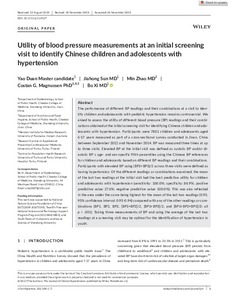Utility of blood pressure measurements at an initial screening visit to identify Chinese children and adolescents with hypertension
Duan Yao; Sun Jiahong; Zhao Min; Magnussen Costan G; Xi Bo
Utility of blood pressure measurements at an initial screening visit to identify Chinese children and adolescents with hypertension
Duan Yao
Sun Jiahong
Zhao Min
Magnussen Costan G
Xi Bo
WILEY
Julkaisun pysyvä osoite on:
https://urn.fi/URN:NBN:fi-fe2021042823087
https://urn.fi/URN:NBN:fi-fe2021042823087
Tiivistelmä
The performance of different BP readings and their combinations at a visit to identify children and adolescents with pediatric hypertension remains controversial. We aimed to assess the utility of different blood pressure (BP) readings and their combinations obtained at the initial screening visit for identifying Chinese children and adolescents with hypertension. Participants were 7831 children and adolescents aged 6-17 years measured as part of a cross-sectional survey conducted in Jinan, China between September 2012 and November 2014. BP was measured three times at up to three visits. Elevated BP at the initial visit was defined as systolic BP and/or diastolic BP >= age- and sex-specific 95th percentiles using the Chinese BP references for children and adolescents based on different BP readings and their combinations. Participants with elevated BP using (BP2+BP3)/2 across three visits were defined as having hypertension. Of the different readings or combinations examined, the mean of the last two readings at the initial visit had the best predictive utility for children and adolescents with hypertension (sensitivity: 100.0%; specificity: 86.9%; positive predictive value: 27.6%; negative predictive value: 100.0%). This was also reflected in the area under the curve being highest for the mean of the last two readings (0.93, 95% confidence interval: 0.93-0.94) compared with any of the other readings or combinations (BP1, BP2, BP3, [BP1+BP2]/2, [BP1+BP3]/2, and [BP1+BP2+BP3]/3; all p < .001). Taking three measurements of BP and using the average of the last two readings at a screening visit may be optimal for the identification of hypertension in youth.
Kokoelmat
- Rinnakkaistallenteet [27094]
